Meetings Past
Nov. 17, 2007 Meeting Highlights
by Mary Jane Dapkus
Merry, red-cheeked members and guests flocked to the historic Edmond Town Hall on November 17, a brisk autumn Saturday morning. Gratefully inhaling the aroma of hot coffee, a spectacle of sumptuously laden mart tables unfolded before them.
Mart offerings included two wooden movement shelf clocks dating from the 2nd quarter of the 19th century bearing seldom seen labels. These graced the table of the (thankfully) inimitable David Ewbank (CT). The first, produced by Smith & Bros. of the Bowery, NYC, contained an 8-d Jeromes & Darrow movement. The second was "...made and sold/by Butler & Henderson/Annapolis, Nova Scotia".
Meeting attendees included the very modest but no less highly skilled cabinet and clock case maker, Andrew Doback of Naugatuck (CT). Perhaps one of Andrew's least known accomplishments is an exquisitely detailed scale model of the ca. 1870 2nd Empire-style Naugatuck Town Hall, regretably now demolished, complete with its tower clock and furnishings. This amazing work is currently on exhibit at the Naugatuck Historical Society Museum.
Our guest speaker was Snowden Taylor, FNAWCC. A retired professor of physics, Snowden is well known for his many significant contributions in the area of the history of American clock making. These include (but are by no means limited to): The Developmental Era of Eli Terry and Seth Thomas Shelf Clocks (1985); keys to Noble Jerome patent 30-hr. brass & related weight-driven movements (Bulletin No. 221 Part II, 1982); and keys to identifying Terry-type 30-hr. wooden movements (Bulletin No. 208, 1980). Together with the late Kenneth Roberts, he is co-author of Eli Terry and the Connecticut Shelf Clock (2 eds., 2nd ed. 1994). Snowden chairs NAWCC's Research Committee, and edits the Bulletin's column "Research Activities & News"--the place many readers, by their own admission, unfailingly turn to first.
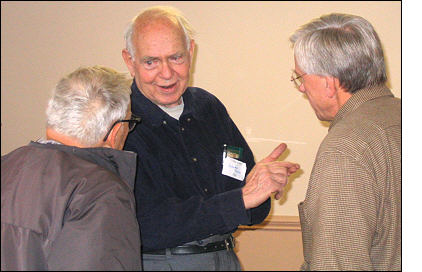 Snowden's presentation, entitled "Joseph Ives: for Good or Bad", traced the innovative groundwork Ives laid for several early technical developments in the manufacture of clock movements. These included wagon springs as power sources, the use of rolled brass and other metals in movement making, and a tin-plate movement of ca. 1860, the precursor of late 19th and early 20th c alarm clock movements. Snowden's presentation, entitled "Joseph Ives: for Good or Bad", traced the innovative groundwork Ives laid for several early technical developments in the manufacture of clock movements. These included wagon springs as power sources, the use of rolled brass and other metals in movement making, and a tin-plate movement of ca. 1860, the precursor of late 19th and early 20th c alarm clock movements.
Snowden's interpretive analysis of the Ives' chronology, which encompassed two bankruptcies and a stint in debtors' prison in New York City, centered around a remarkable collection of photographs. His cast of characters ranged from "Uncle Joe" Ives himself, to a warmly supportive community and an unrepentant villain. Although Ives demonstrated nearly utter incompetence relative to financial exigencies of his business, peculiar extravagances and awkward contrivances punctuated moments of sheer brilliance reveal themselves in his work. Thus Snowden compellingly characterized Ives' legendary achievements.
Snowden's longstanding, intense interest in movements, labels, and unrestored clocks as primary source data has caused them to yield many wonderful secrets that might otherwise have gone undiscovered. No less important, however, is the assistance, encouragement, and inspiration he abundantly provides others over an amazingly broad field of technical and research interests that has multiplied such discoveries.
Special thanks is due to a small army of talented, creative, energetic, and gracious chapter volunteers. In particular, we thank Lou Sadowski, Peter Beliveau, Don & Carol Montory, Don Bruno, and Cheryl Comen, whose efforts provided hosptiality and wonderful surprises for members during 2007.
Happy holidays!
-- Mary Jane
Sept. 15, 2007 Meeting Highlights
by Jim Katzin, Pres.
It was a drizzly Saturday morning when CT Chapter 148 met for its September 15 meeting, but the weather did not deter the 150 or so clock and watch enthusiasts from making it to the Mart. Extra tables had to be found to satisfy all of the sellers, and the trading was furious all morning.
Our speaker for the day was Bernie Stoltie, who gave a fascinating and informative presentation on early Japanese clocks. From his first slide of a clepsydra, which he explained was used more for measuring the amount of water doled out to farmers than it was for timekeeping, to the beautiful incense burner ‘timers’, he kept his audience thoroughly entertained. The incense burner was a fascinating time keeping device, but not particularly accurate. The burner was essentially a metal box with a maze formed in it, into which the incense powder was placed. Mr. Stoltie explained that different scented incense would be placed in the separate parts of the channel, and as the incense burned, the changing scents would indicate the passing of time. Mr. Stoltie also showed numerous examples of bracket clocks with foliot mechanisms, as well as stick clocks and others.
* * *
July 21, 2007 Meeting Highlights
by Mary Jane Dapkus
The July meeting of Chapter 148 convened at the Edmond Town Hall on Saturday the 21st. Members sadly recalled one of their number, Dana Blackwell of Naugatuck, CT, who passed away on June 14.
No biographical sketch of Dana would be complete without mentioning his accomplishments as author, lecturer, classical scholar, worldwide horological consultant and restorer, designer of aircraft instrumentation, and collector. Dana's lifelong involvement with horology included a career with the Howard Clock Products Company, culminating with his selection as the firm's president. Dana's skills earned him a directorship at the American Clock and Watch Museum, a post he held until the 1990s. Dana was a member of the Antiquarian Horological Society, and a founding member and first president of the Naugatuck Historical Society (CT).
Despite a demanding schedule, Dana found time to instruct others in mechanical horology. Dean Spencer of Cheshire, CT a carpenter and electronics expert by trade, is privileged to be one of a number of chapter members to attribute skills and a high level of connoisseurship to Dana's legacy. Dean learned the craft of repairing fine, precision weight-driven regulators from Dana, and recalls pleasant times.
In the spirit of Dana's legacy, David Follett volunteered an informal educational program centering around a Timothy Cheney, East Hartford, Connecticut tall clock movement with a fine English dial, both dating from the third quarter of the 18th century. David shared skills such as distinguishing hand-sawn teeth from milled and machine sawn types, enhancing the listener's knowledge and appreciation for American antique tall clocks. Self-taught watch repairer Don Peach of Southington, CT contributed a lesson in special-issue railroad watches.
The meeting also featured a more formal presentation, given by Tom Grimshaw (CT), focusing on connoisseurship from a rather unusual perspective. Tom, a distinguished collector, longtime restorer, researcher, lecturer, and learner, possesses both an uncanny eye and a deep connection with antique clocks--particularly those that might initially appear "ordinary".
Using objects dating from the 19th to mid-20th centuries exerpted from his remarkable collection, Tom shared one intellectual thrill of discovery after another. These pleasures included (but were by no means limited to) an ogee case containing a very rare prototype "Kirk's patent" iron-backplate movement; a German crystal regulator clock ca. 1893 with an operating Ferris wheel above, commemorating the Columbian Exposition of 1893 held in Chicago; an electric radio clock in a wooden case ca. 1950; and an unusual cottage clock with a scrimshaw tablet.
|
|
|
| Ferris wheel clock, German (possibly Junghans?), ca. 1893. |
Guest speaker Tom Grimshaw answering questions on rare and unusual clocks.
|
Thanks is due not only to Tom for contributing generously of his time, talent, and efforts, but also to the many other members whose valuable assistance helped transform the July meeting into an extraordinary event!
* * *
May 19, 2007 Meeting Highlights
by Mary Jane Dapkus
Chapter 148 meetings attract record numbers of attendees; sold-out mart tables in the Edmond Town Hall gymnasium continue to be the norm. The May meeting reinforced this happy trend.
Member Bob Mills discussed a rare S. B. Terry brass clock movement from his collection, while transferring the object to a fellow member for in-depth care. A long-time collector, Bob finally has some time to research and reconnect with the objects in his collection. This particular clock came with a Litchfield, CT provenance and documentation. Meanwhile, Dominick Eremito offered a fit-up device for use in repairing chiming tall clocks at the silent auction.
We wish Harry Blair a speedy recovery upon his return home after surgery. In addition, we miss Bob Hansen, who at age 94 generally remains homebound. As members may recall, for many years Bob presided over a pair of mart tables that never failed to yield some extraordinary finds.
We regret learning that member Jay Townsend passed away recently. We send our condolences to Jay's wife Ann, a long time, greatly appreciated volunteer, who, together with Ethel Weber, elegantly presided over our mart's refreshment table.
David Follett elevated our meeting to regal heights, graciously exhibiting of a pair of unique English lantern clocks ca. 1620 - 1650. These lovely examples were signed by their maker, Peter Closon, who provided his location as "neere Holbourne Bridge/Londini fecit". Queen Elizabeth's bedchamber (ca. mid-19th c) reportedly contained a similar example. A wonderful story associated with these particular clocks is their timely rescue from the brink of destruction, as they were about to be melted down to obtain brass for World War II munitions.
After the mart, expert repairers Jim Katzin and Don Bruno teamed to present a clock movement troubleshooting workshop. Jim led the brass segment of the workshop; Don provided the wooden movement segment.
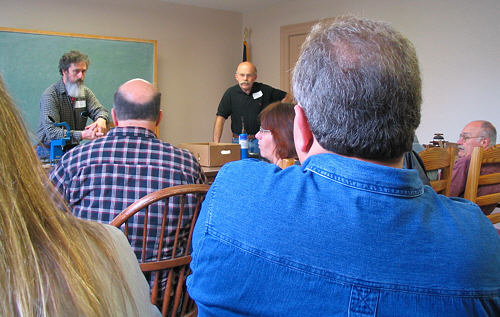
Jim (left presenter) and Don skillfully reviewed various basic equipment types and operations, including test stands, straightening of bent teeth, proper cleaning, problems with strike trains, and bushing materials and processes for both wooden and brass movements. The program afforded fresh ideas not only for those who perform repairs infrequently, but also for seasoned amateurs and professional-level repairers.
The flyer notifying members of this meeting and workshop encouraged members to bring problem movements. In response to intense audience interest, Jim and Don continued to answer questions and diagnose problems long after the speaking portion of the workshop ended, and the afternoon sun's rays began penetrating the west windows of the Edmond Town Hall's historic hearing room.
We extend our hearty thanks to Jim and Don for their affable generosity in providing this most relaxed, enjoyable, insightful, and beneficial workshop.
January 20, 2007 Meeting Highlights
by Mary Jane Dapkus
Collecting reflects mankind's natural curiosity. Each may comprise a compelling force in our lives.
Chapter 148 met on January 20, 2007, a blustery Saturday morning. Despite frigid temperatures and near-zero wind chill, members and table holders filled the Edmond Town Hall gymnasium. There they encountered an abundance of mart treasures guaranteed to ignite and sustain the curious psyche. Moreover, they were greeted by kindred spirits and merry friends.
Although the chapter's traditional January meeting does not feature a guest speaker, table holders dispensed restoration and identification tips along with more tangible wares, including a very diverse selection of clocks and watches, clock and watch parts, and an excellent offering of horological reference books and tools.
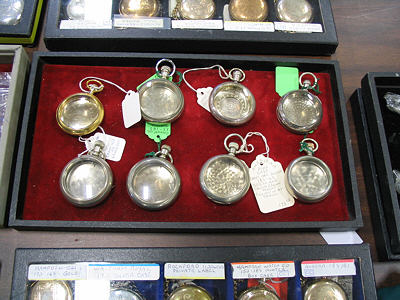
Here is such an example: a collection of watch cases offered by tableholder John Hotz.
The mart also provided an opportunity to examine skillful restoration projects, including a period Tmothy Chandler shelf clock with cast brass "grandmother clock" movement exhibited by member David Follett.
The Naugatuck Valley Historical Society Museum is presently exhibiting a unique collection of Salem Bridge type shelf clocks. The exhibit is housed in the Society's historic railroad station building, and is open to the public. Members wishing to take advantage of the opportunity to view the collection are encouraged to call the Society at (203) 727-9039 for hours and information.
Happy New Year to all!
Meetings In 2006
Meetings In 2005
Meetings In 2004
Meetings In 2003
Meetings In 2002
Meetings In 2001
Meetings In 2000
Meetings In 1999
Meetings In Years 1996 - 1998
|
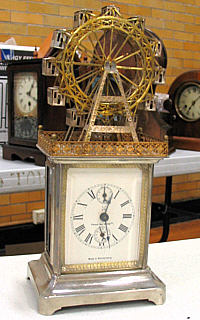
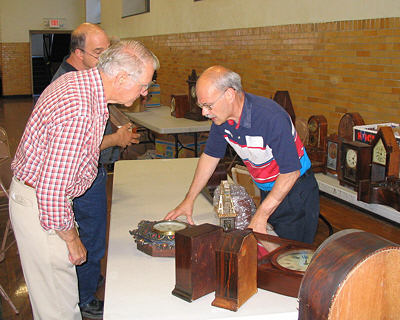


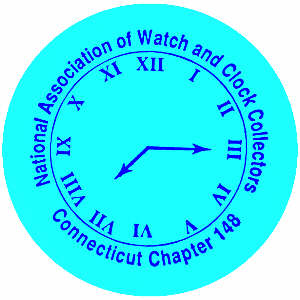
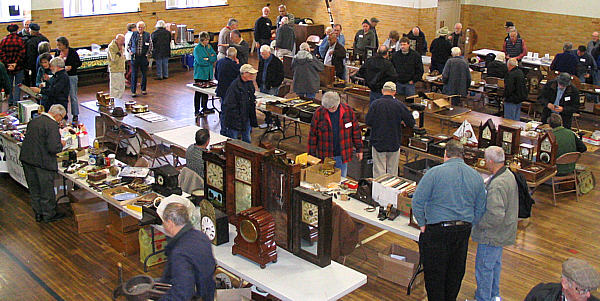
 Snowden's presentation, entitled "Joseph Ives: for Good or Bad", traced the innovative groundwork Ives laid for several early technical developments in the manufacture of clock movements. These included wagon springs as power sources, the use of rolled brass and other metals in movement making, and a tin-plate movement of ca. 1860, the precursor of late 19th and early 20th c alarm clock movements.
Snowden's presentation, entitled "Joseph Ives: for Good or Bad", traced the innovative groundwork Ives laid for several early technical developments in the manufacture of clock movements. These included wagon springs as power sources, the use of rolled brass and other metals in movement making, and a tin-plate movement of ca. 1860, the precursor of late 19th and early 20th c alarm clock movements.